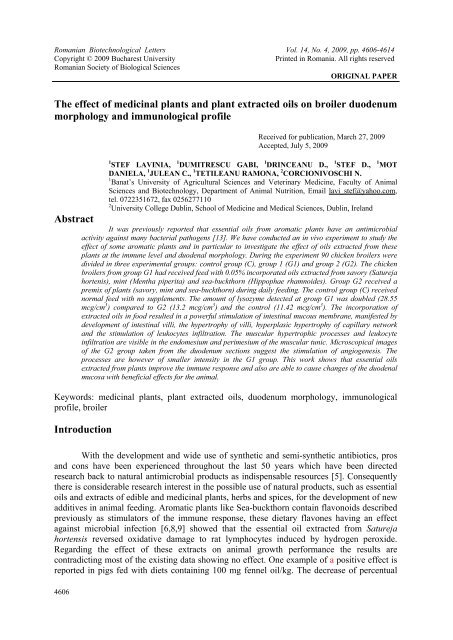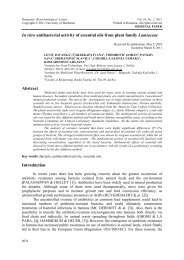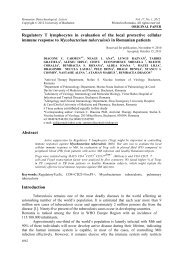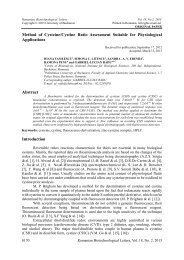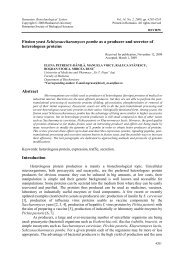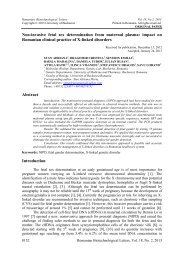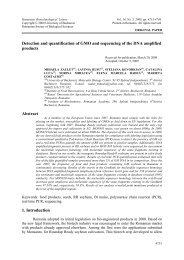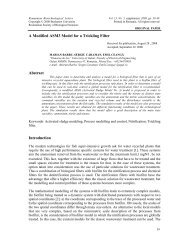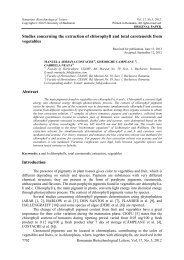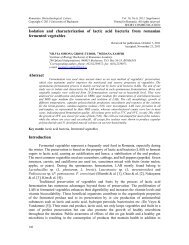The effect of medicinal plants and plant extracted oils ... - Rombio.eu
The effect of medicinal plants and plant extracted oils ... - Rombio.eu
The effect of medicinal plants and plant extracted oils ... - Rombio.eu
You also want an ePaper? Increase the reach of your titles
YUMPU automatically turns print PDFs into web optimized ePapers that Google loves.
<strong>The</strong> <strong>effect</strong> <strong>of</strong> <strong>medicinal</strong> <strong><strong>plant</strong>s</strong> <strong>and</strong> <strong>plant</strong> <strong>extracted</strong> <strong>oils</strong> on broiler duodenum morphology<strong>and</strong> immunological pr<strong>of</strong>ileFig. 2. Control lot – section through duodenum – general (100x; Mallory trichromical coloration)Fig. 3. Control lot – section through duodenum– intestinal gl<strong>and</strong>s (100x; Mallory trichromical coloration)Fig. 4. Experimental lot with <strong>oils</strong> (ELO) – section through duodenum– general (100x; Mallory trichromical coloration)Fig. 5. Experimental lot with <strong>oils</strong> (ELO) – section through duodenum– intestinal villositys (400x; Mallory trichromical coloration)<strong>The</strong> capillary network shows evidence <strong>of</strong> hyperplasia <strong>and</strong> hypertrophy (fig. 6). In theG1 group, the intestinal gl<strong>and</strong>s <strong>of</strong> the duodenum appear to have a large lumen, are delimitedby thin intergl<strong>and</strong>ular spaces, with the intergl<strong>and</strong>ular villi containing collagen fibres,Rom. Biotechnol. Lett., Vol. 14, No. 4, 4606-4614 (2009) 4611
<strong>The</strong> <strong>effect</strong> <strong>of</strong> <strong>medicinal</strong> <strong><strong>plant</strong>s</strong> <strong>and</strong> <strong>plant</strong> <strong>extracted</strong> <strong>oils</strong> on broiler duodenum morphology<strong>and</strong> immunological pr<strong>of</strong>ileFig. 9. Experimental lot with <strong>oils</strong> (ELO) – section through duodenum – ectasiate capillary <strong>and</strong> l<strong>eu</strong>kocytesinfiltrate in mucous muscular tunics (400x; Mallory trichromical coloration)For group G2 the intestinal mucous villi are very high (fig. 10) approximately. 1410,coated with a tall monolayer <strong>of</strong> epithelium (approximately. 23.5 ), with an obvious ridgedbase. <strong>The</strong> enterocytes contain oval nuclei, placed in the basal third <strong>of</strong> the cell, with manycalceiform cells dispersed among them.Fig. 10. Experimental lot with <strong><strong>plant</strong>s</strong> (ELP) – section through duodenum– intestinal villositys (100x; Mallory trichromical coloration)<strong>The</strong> duodenal villi appears to be made up <strong>of</strong> a lax connective tissue, including theBruke muscle, a hyperplastic capillary network <strong>and</strong> many migrating l<strong>eu</strong>kocytes. <strong>The</strong>se imagesthrough the duodenum suggest that the angiogenesis process has been stimulated, judging bythe presence <strong>of</strong> the capillary ectasia in the main villi <strong>and</strong> intergl<strong>and</strong>ular villi.<strong>The</strong> capillary network appears to undergo both hyperplasia <strong>and</strong> hypertrophy <strong>and</strong> isseen to be powerfully stimulated by the lymphoid infiltrate (fig. 11). <strong>The</strong> muscle <strong>of</strong> themucosa is formed from two thin layers <strong>of</strong> flat muscular fibres, <strong>and</strong> in the submucosa, thesanguine vessels have a large lumen. In this paper we report the positive <strong>effect</strong> <strong>of</strong> essential<strong>oils</strong>, <strong>extracted</strong> from aromatic <strong><strong>plant</strong>s</strong>, at the intestinal level having as a consequence animproved immunological response. This work provides the data regarding the changes in themicroscopic structure <strong>of</strong> chicken duodenum as a consequence <strong>of</strong> aromatic <strong>plant</strong> <strong>extracted</strong>essential <strong>oils</strong> present in their feed. <strong>The</strong> histological changes presented here provide newinformation regarding the potential for using aromatic <strong><strong>plant</strong>s</strong> <strong>and</strong> aromatic <strong><strong>plant</strong>s</strong> <strong>oils</strong> inchicken feed.Rom. Biotechnol. Lett., Vol. 14, No. 4, 4606-4614 (2009) 4613
STEF LAVINIA, DUMINTRESCU GABI, DRINCEANU D., STEF D.,MOT DANIELA, JULEAN C., TETILEANU RAMONA, CORCIONIVOSCHI N.Fig. 11. Experimental lot with <strong><strong>plant</strong>s</strong> (ELP) – section through duodenum – hyperplasic hypertrophy <strong>of</strong> capillarynetwork <strong>and</strong> stimulation <strong>of</strong> l<strong>eu</strong>kocytes infiltrate (400x; Mallory trichromical coloration)AcknowledgementsThis work was partially supported by the Romanian Ministry <strong>of</strong> Education <strong>and</strong>Research, grant CNCSIS, number 51, 2005-2007.References1. ANTAR R.S., HARMS R.H., SHIVAZAD M., FARIA D.E., RUSSELL G.B.. Performance <strong>of</strong>commercial laying hens when six percent corn oil is added to the diet at various ages <strong>and</strong> with differentlevels <strong>of</strong> tryptophan <strong>and</strong> protein. Poult Sci. 83(3):447-55, (2004).2. CRESPO N, ESTEVE-GARCIA E., Polyunsaturated fatty acids reduce insulin <strong>and</strong> very low densitylipoprotein levels in broiler chickens. Poult Sci. 82(7):1134-9, (2003)3. CRESPO N., ESTEVE-GARCIA E., Nutrient <strong>and</strong> fatty acid deposition in broilers fed different dietaryfatty acid pr<strong>of</strong>iles. Poult Sci. 81(10):1533-42, (2002).4. ENGBERG R.M., LAURIDSEN C., JENSEN S.K., JAKOBSEN K. Inclusion <strong>of</strong> oxidized vegetable oilin broiler diets. Its influence on nutrient balance <strong>and</strong> on the antioxidative status <strong>of</strong> broilers. Poult Sci.75(8):1003-11, (1996).5. FERRINI G., BAUCELLS M.D., ESTEVE-GARCÍA E., BARROETA A.C. Dietary polyunsaturatedfat reduces skin fat as well as abdominal fat in broiler chickens. Poult Sci. 87(3):528-35. (2008).6. GRABLEY S., THIERICKE R. Bioactive agents from natural sources: trends in discovery <strong>and</strong>application. Adv Biochem Eng Biotechnol. 64:101-54, 1999.7. JAIN M., GANJU L., KATIYAL A., PADWAD Y., MISHRA K.P., CHANDA S., KARAN D.,YOGENDRA K.M., SAWHNEY R.C.. Effect <strong>of</strong> Hippophae rhamnoides leaf extract against Denguevirus infection in human blood-derived macrophages. Phytomedicine. 15(10):793-9. (2008)8. KAMEL C. Tracing modes <strong>of</strong> action <strong>and</strong> the roles <strong>of</strong> <strong>plant</strong> extracts in non-ruminants. Pages 135-150 inRecent Advances in Animal Nutrition. P.C.Garnsworthy<strong>and</strong> J. Weiseman, ed. Nottingham UniversityPress, Nothingham, UK. 2001.9. MISHRA KP, CHANDA S, KARAN D, GANJU L, SAWHNEY RC. Effect <strong>of</strong> Sea-buckthorn(Hippophae rhamnoides) flavone on immune system: an in-vitro approach. Phytother Res. 20, (2008).10. MOSAFFA F., BEHRAVAN J., KARIMI G., IRANSHAHI M. Antigenotoxic <strong>effect</strong>s <strong>of</strong> Saturejahortensis L. on rat lymphocytes exposed to oxidative stress. Arch Pharm Res. 29(2):159-64. (2006).11. NRC – Nutrient Requirements <strong>of</strong> Poultry, MAS, Washington, (1994)12. OLOYO R.A., OGUNMODEDE B.K. Preliminary investigation on the <strong>effect</strong> <strong>of</strong> dietary supplementalbiotin <strong>and</strong> palm kernel oil on blood, liver <strong>and</strong> kidney lipids in chicks. Arch Tierernahr. 42(3-4):263-72.(1992).13. PARVU C. Plant Universe, Ed. ENCICLOPEDIC, Bucharest, 2008.14. ROTA C, CARRAMIÑANA J.J, BURILLO J, HERRERA A. In vitro antimicrobial activity <strong>of</strong> essential<strong>oils</strong> from aromatic <strong><strong>plant</strong>s</strong> against selected foodborne pathogens. J Food Prot. 67(6):1252-6,(2004).15. SCHÖNE F., VETTER A., HARTUNG H., BERGMANN H., BIERTÜMPFEL A., RICHTER G.,MÜLLER S., BREITSCHUH G, Effects <strong>of</strong> essential <strong>oils</strong> from fennel (Foeniculi aetherol<strong>eu</strong>m) <strong>and</strong>caraway (Carvi aetherol<strong>eu</strong>m) in pigs. J Anim Physiol Anim Nutr (Berl). 90(11-12):500-10, ( 2006).16. WILLIS W.L., REID L. Investigating the <strong>effect</strong>s <strong>of</strong> dietary probiotic feeding regimens on broilerchicken production <strong>and</strong> Campylobacter jejuni presence. Poult Sci. 87(4):606-11. (2008).4614Rom. Biotechnol. Lett., Vol. 14, No. 4, 4606-4614 (2009)


